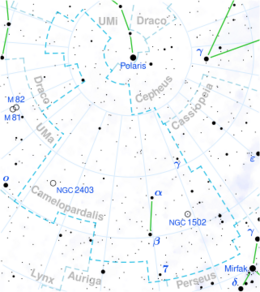Astronomy:HD 21819
| Observation data Epoch J2000.0 Equinox (celestial coordinates) | |
|---|---|
| Constellation | Camelopardalis |
| Right ascension | 03h 33m 39.06000s[1] |
| Declination | +54° 58′ 29.4970″[1] |
| Apparent magnitude (V) | 5.97±0.01[2] |
| Characteristics | |
| Evolutionary stage | main sequence star[3] |
| Spectral type | A3 V[4] or A2 Vp[5] |
| B−V color index | +0.11[6] |
| Astrometry | |
| Radial velocity (Rv) | −6.5±1.5[7] km/s |
| Proper motion (μ) | RA: −41.053[1] mas/yr Dec.: −0.357[1] mas/yr |
| Parallax (π) | 13.1723 ± 0.0317[1] mas |
| Distance | 247.6 ± 0.6 ly (75.9 ± 0.2 pc) |
| Absolute magnitude (MV) | +1.62[8] |
| Details | |
| Mass | 2.00+0.19−0.15[9] M☉ |
| Radius | 2.06±0.10[10] R☉ |
| Luminosity | 30.6+2.2−2.0[3] L☉ |
| Surface gravity (log g) | 4.08[11] cgs |
| Temperature | 9,000[12] K |
| Metallicity [Fe/H] | −0.17[11] dex |
| Rotational velocity (v sin i) | 160±8[5] km/s |
| Age | 737±102[9] Myr |
| Other designations | |
| Database references | |
| SIMBAD | data |
HD 21819, also designated as HR 1073, is a solitary star[14] located in the northern circumpolar constellation Camelopardalis. It has an apparent magnitude of 5.97,[2] making faintly visible to the naked eye under ideal conditions. The object is located relatively close at a distance of 248 light-years based on Gaia DR3 parallax measurements[1] and it is drifting closer with a heliocentric radial velocity of −6.5 km/s.[7] At its current distance, HD 21819's brightness is diminished by an interstellar extinction of 0.17 magnitudes[15] and it has an absolute magnitude of +1.62.[8]
HD 21819 has a stellar classification of A3 V,[4] indicating that it is an ordinary A-type main-sequence star that is generating energy via hydrogen fusion at its core. Abt & Morell (1995) gave a slightly hotter star of A2 Vp,[5] indicating that it is instead an Ap star with weak magnesium lines. It has twice the mass of the Sun[9] and 2.06 times the radius of the Sun.[10] It radiates 30.6 times the luminosity of the Sun[3] from its photosphere at an effective temperature of 9,000 K,[12] giving it a white hue when viewed in the night sky. HD 21819 is metal deficient with an iron abundance of [Fe/H] = −0.17 or 67.6% of the Sun's[11] and it is estimated to be 737 million years old,[9] having completed 55.7% of its main sequence lifetime.[3] Like most hot stars it spins rapidly, having a projected rotational velocity of 160 km/s.[5]
References
- ↑ 1.0 1.1 1.2 1.3 1.4 Vallenari, A. et al. (2022). "Gaia Data Release 3. Summary of the content and survey properties". Astronomy & Astrophysics. doi:10.1051/0004-6361/202243940 Gaia DR3 record for this source at VizieR.
- ↑ 2.0 2.1 Høg, E.; Fabricius, C.; Makarov, V. V.; Urban, S.; Corbin, T.; Wycoff, G.; Bastian, U.; Schwekendiek, P. et al. (March 2000). "The Tycho-2 catalogue of the 2.5 million brightest stars". Astronomy and Astrophysics 355: L27–L30. ISSN 0004-6361. Bibcode: 2000A&A...355L..27H.
- ↑ 3.0 3.1 3.2 3.3 Zorec, J.; Royer, F. (January 2012). "Rotational velocities of A-type stars IV: Evolution of rotational velocities". Astronomy & Astrophysics 537: A120. doi:10.1051/0004-6361/201117691. ISSN 0004-6361. Bibcode: 2012A&A...537A.120Z.
- ↑ 4.0 4.1 Cowley, A.; Cowley, C.; Jaschek, M.; Jaschek, C. (April 1969). "A study of the bright stars. I. A catalogue of spectral classifications.". The Astronomical Journal 74: 375. doi:10.1086/110819. ISSN 0004-6256. Bibcode: 1969AJ.....74..375C.
- ↑ 5.0 5.1 5.2 5.3 Abt, Helmut A.; Morrell, Nidia I. (July 1995). "The Relation between Rotational Velocities and Spectral Peculiarities among A-Type Stars". The Astrophysical Journal Supplement Series 99: 135. doi:10.1086/192182. ISSN 0067-0049. Bibcode: 1995ApJS...99..135A.
- ↑ Häggkvist, L.; Oja, T. (1969). "Photoelectric BV photometry of 368 northern stars". Arkiv for Astronomi 5: 125–135. ISSN 0004-2048. Bibcode: 1969ArA.....5..125H.
- ↑ 7.0 7.1 Gontcharov, G. A. (November 2006). "Pulkovo Compilation of Radial Velocities for 35,495 Hipparcos stars in a common system". Astronomy Letters 32 (11): 759–771. doi:10.1134/S1063773706110065. ISSN 1063-7737. Bibcode: 2006AstL...32..759G.
- ↑ 8.0 8.1 Anderson, E.; Francis, Ch. (May 2012). "XHIP: An extended hipparcos compilation". Astronomy Letters 38 (5): 331–346. doi:10.1134/S1063773712050015. ISSN 1063-7737. Bibcode: 2012AstL...38..331A.
- ↑ 9.0 9.1 9.2 9.3 David, Trevor J.; Hillenbrand, Lynne A. (12 May 2015). "The Ages of Early-type Stars: Strömgren Photometric Methods Calibrated, Validated, Tested, and Applied to Hosts and Prospective Hosts of Directly Imaged Exoplanets". The Astrophysical Journal 804 (2): 146. doi:10.1088/0004-637X/804/2/146. Bibcode: 2015ApJ...804..146D.
- ↑ 10.0 10.1 Kervella, P.; Thévenin, F.; Di Folco, E.; Ségransan, D. (April 8, 2004). "The angular sizes of dwarf stars and subgiants: Surface brightness relations calibrated by interferometry". Astronomy & Astrophysics 426 (1): 297–307. doi:10.1051/0004-6361:20035930. ISSN 0004-6361. Bibcode: 2004A&A...426..297K.
- ↑ 11.0 11.1 11.2 Anders, F. et al. (August 2019). "Photo-astrometric distances, extinctions, and astrophysical parameters for Gaia DR2 stars brighter than G = 18". Astronomy & Astrophysics 628: A94. doi:10.1051/0004-6361/201935765. ISSN 0004-6361. Bibcode: 2019A&A...628A..94A.
- ↑ 12.0 12.1 Philip, A. G. D.; Egret, D. (May 1980). "An analysis of the Hauck-Mermillod catalogue of homogeneous four-color data. II.". Astronomy and Astrophysics Supplement Series 40: 199–205. ISSN 0365-0138. Bibcode: 1980A&AS...40..199P.
- ↑ "HD 21819". SIMBAD. Centre de données astronomiques de Strasbourg. http://simbad.u-strasbg.fr/simbad/sim-basic?Ident=HD+21819.
- ↑ De Rosa, R. J. et al. (26 November 2013). "The VAST Survey – III. The multiplicity of A-type stars within 75 pc". Monthly Notices of the Royal Astronomical Society 437 (2): 1216–1240. doi:10.1093/mnras/stt1932. ISSN 0035-8711. Bibcode: 2014MNRAS.437.1216D.
- ↑ Gontcharov, George A.; Mosenkov, Aleksandr V. (28 September 2017). "Verifying reddening and extinction for Gaia DR1 TGAS main sequence stars". Monthly Notices of the Royal Astronomical Society 472 (4): 3805–3820. doi:10.1093/mnras/stx2219. ISSN 0035-8711. Bibcode: 2017MNRAS.472.3805G.
 |


